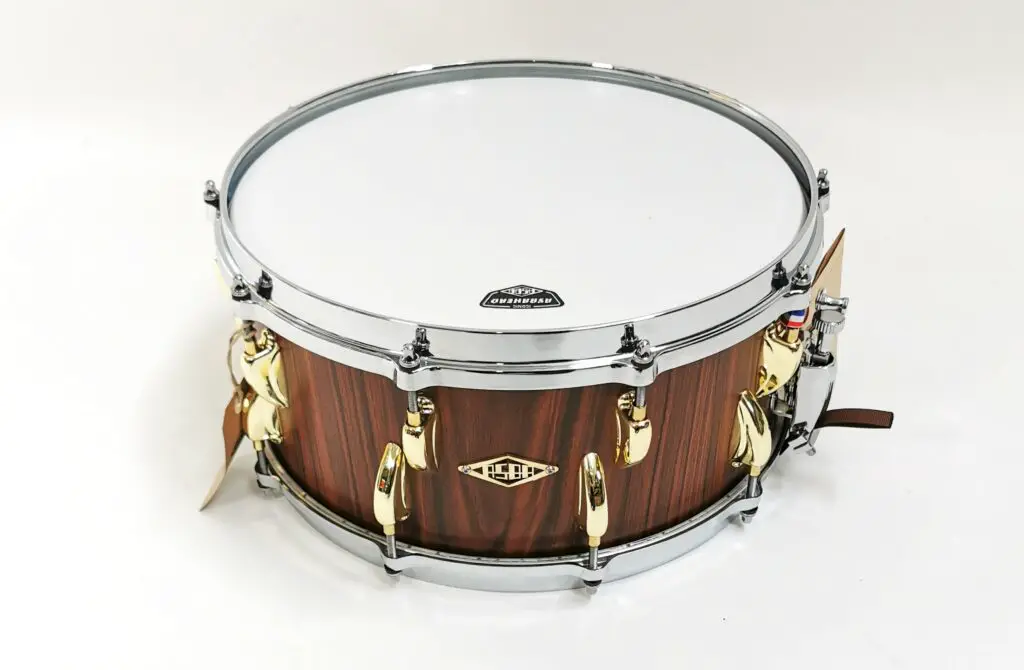Birch and maple are two of the most common woods used to construct drum shells, but what’s the difference between them? In this article I’ll directly compare these two drum shell materials to help you decide which to choose.
Birch vs Maple Drums
Maple drums have a warmer sound with more bass and sustain compared to birch drums which have a brighter and crisper sound with a faster attack. Maple drums are good for softer styles of music, whereas birch drums are preferred for more aggressive styles such as metal. Maple drums are more expensive.
| Maple Drum | Birch Drum |
| Warm and rounded sound | Bright and punchy sound |
| Slow attack, long sustain | Fast attack, short sustain |
| Good for jazz, indie and rock | Good for metal and rock |

Effect on the Sound
Birch drums sound brighter and sharper in comparison to maple drums which sound warmer and fuller. Maple drums offer more sustain, whereas birch drums have a faster attack. The differences are subtle and the head, construction and size of the drum typically has a bigger effect on the sound.
Check out this YouTube video to hear the differences (maple on left, birch on right).
EQ Balance
This refers to how bright or warm the drum sounds. Maple drums have a much warmer sound compared to birch drums which sound sharper and brighter. This is because maple favours bass frequencies, whereas birch favours treble frequencies.
The emphasis that maple puts on the bass frequencies produces a mellow and more rounded sound. On the other hand, birch’s emphasis on the treble allows it to cut through the mix more and sounds more aggressive and bright.
Attack and Sustain
Let’s define what these two words mean:
- Attack: this refers to the build up of a note. A sound with a fast attack reaches the maximum frequency more quickly. In contrast, a sound with a slower attack takes longer to build up.
- Sustain: refers to how long a sound resonates. The more sustain a sound has, the longer it will be heard for.
Maple offers more sustain, but a slower attack compared to birch. In other words, birch sounds more “punchy” and aggressive compared to maple which sounds more relaxed.

Music Style Suitability
It is possible to use birch and maple drums for any music style, but there are some styles that in general favour one type of wood over the other:
- Metal: birch drum shells are often used for metal because they cut through the mix more and sound more punchy and direct which is useful for fast fills.
- Rock: birch and maple are both popular for rock. For a warmer and more relaxed tone, maple is often chosen whereas for a faster and more upbeat track, birch is a good choice.
- Jazz: maple is a good choice for jazz as it sounds warmer than birch which can sound a bit too aggressive.
Recording and Playing Live
Again, there aren’t any hard and fast rules as to which type of wood suits different situations the most. However, birch drum shells are a very popular choice for recording studios because they have less sustain and are easier to control. Maple is a popular choice for on stage as it has more sustain.
Price Difference
Maple drums are typically more expensive compared to birch drums. Maple is a more expensive wood to source which means the drums usually cost around 20-40% more than an equivalent birch drum.
Check out the table below for examples.
| Pearl Snare Drum | Price | Wood |
| VPX Strata | $110 | Birch |
| Vision | $130 | Birch |
| Modern Utility | $170 | Maple |
| Masters | $430 | Maple |
| Masters BCX | £480 | Birch |
| Sensitone Premium | $490 | Maple |
| Symphonic | $656 | Maple |
| Music City Custom | $1050 | Maple |
Physical Characteristics
Maple is a denser wood in comparison to birch. This means that a maple drum shell is heavier than a birch drum shell, assuming that the thickness and size is the same.
- Birch has an average density of 670 kg/m3
- Maple has an average density of 710 kg/m3
Here are some more articles you might find useful:
